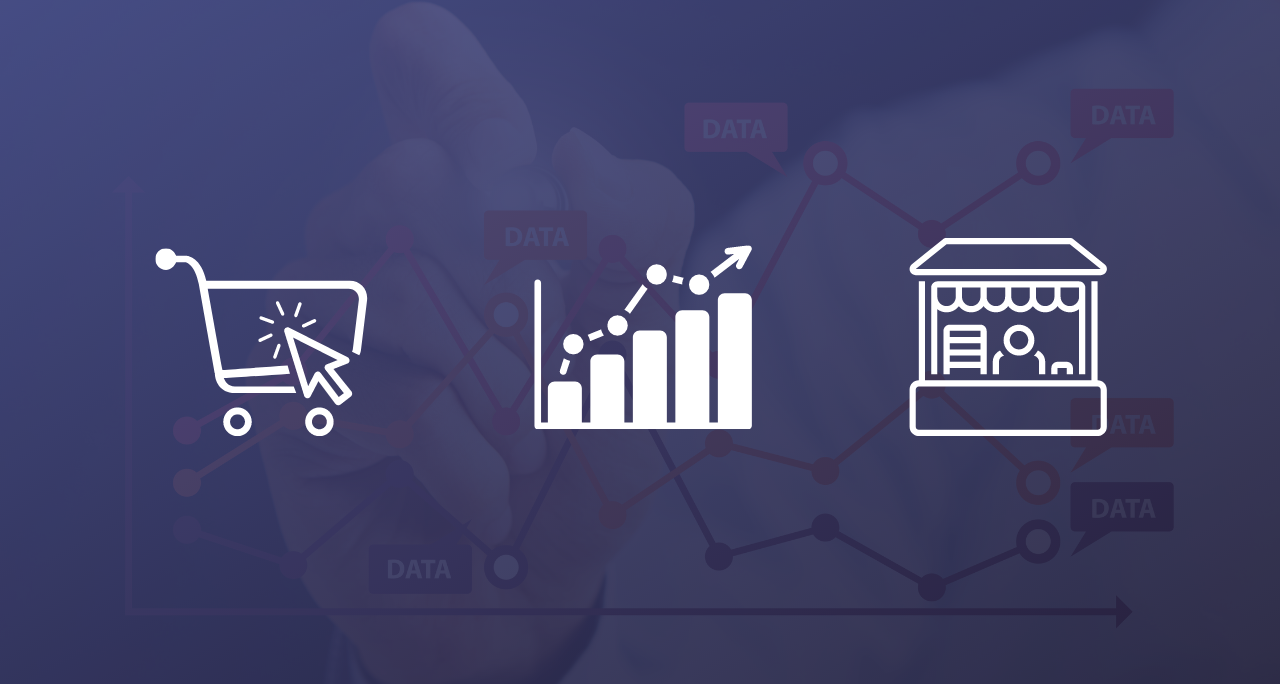In the past few decades, the eCommerce environment has seen significant growth and innovation, offering people all around the world various options to shop online for diversified products and services. Their purchases are delivered directly to their front doors or are downloadable right away, straight from the online store. With all these eCommerce features, people no longer have to worry about spending too much time shopping for clothes, food, or basically anything else.
Nowadays, with the rise of a global pandemic that has affected businesses all over the world, it can be difficult to stay on track and adapt to the new surroundings. So, in order to slow and stop the spread of the virus, many companies have been shut down worldwide, including restaurants, bars, cinemas, and stores, and people have been encouraged to stay indoors and work from home. With all these adjustments have come some serious consequences that affect the workflows and careers of many people. The retail industry has seen significant transformation, and according to a forecast created by Statista, the amount of global retail sales from 2018 to 2022 has dropped unquestionably. In 2020, global retail sales were expected to fall by 5.7% as a result of the COVID-19 pandemic.

Although the retail industry is dealing with a transformation, there is still light at the end of the tunnel. Don’t get overwhelmed by the negative aspects of the present situation, as there are many ways to adapt and build a new perspective for your retail business. For example, you can decide to move your business into the eCommerce world, or just improve your market approach – it all depends on your business plan and what journey you think suits it best.
We’ve got you covered with this aspect, consistently bringing you updates on eCommerce markets, statistics, and insights that can help you optimize, understand shopper’s behavior, and shape the future of your retail business.
The rise of eCommerce
There is no doubt that in the present times, people prefer buying and shopping online, as it takes less time and resources to do so and is also beneficial as we practice social distancing. According to a research from Statista, is it estimated that in 2021 there will be more than 2.14 billion of digital buyers from all around the world, a big increase compared to 2017, when there were 1.66 billion digital buyers. The current world leader of the eCommerce market is China, which in 2019 had $826.6 billion eCommerce sales. This total number is estimated to double by 2024, as a result of the ongoing growth of eCommerce.
Online shopping is convenient, with a lot of options available and all at the click of a button. People can browse online for grocery stores, and then five minutes later jump into searching for fashion items on a different store website. A shopping frequency survey recently showed that 20% of online shoppers from all over the world are shopping physical goods from online stores at least once a week, and 58% say that the reason they prefer to do so is because they can shop anywhere, anytime. Considering the current times, the coronavirus pandemic is pushing people to shop for items online, as shown by a recent U.S. Online Grocery Survey, in which almost half of consumers claimed that they are now shopping for groceries online.
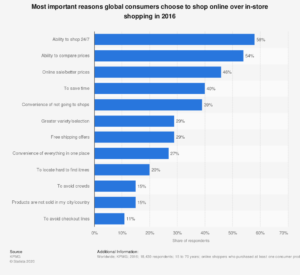
Shopper behavior, expectations, and preferences
We covered some important key findings about shoppers and how and why they prefer to shop online, but because they are a reflection of a brand and play a crucial role for the eCommerce industry, we’ve come up with some even more interesting figures you should know.
First, whether a person decides to browse the online stores to shop or go directly into a retail store, most of their initial research is done on the internet. Their decision begins online, and that is why every company should have a strong online presence to not only showcase their products but also to establish their relationship with their customers. Investing in online touchpoints such as social media or review websites can be a smart decision for your brand.
With eCommerce on the rise, there is no doubt that technology is growing side by side with it. A report from the National Retail Federation reveals that 80% of online shoppers believe that innovation and technologies are playing an important role in their buying process, as they improve their overall shopping experience. Consumers are very interested in using technology for their needs, which is why AI (artificial intelligence) is enhancing shoppers’ experiences in digital commerce, whether it’s chatbots, AI that personalizes marketing campaigns for individuals, voice assistance, or non-manual cash registers in retail sectors. Shoppers are attracted to solutions that take the confusion out of their shopping experience, like getting accurate information on items, prices, and stocks. Many eCommerce businesses are already using AI to facilitate consumers’ experiences while buying from their digital store.
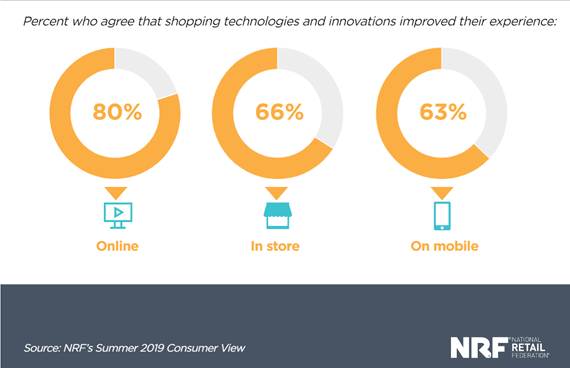
To have success in the eCommerce world, besides having a well-designed and accessible website, you must gain traffic to your digital store. How can you make this happen? Well, by building a strong presence on social media, creating a long-lasting relationship with your customers, and investing in SEO strategies. According to Statista, direct navigation and SEO represent the leading traffic drivers.
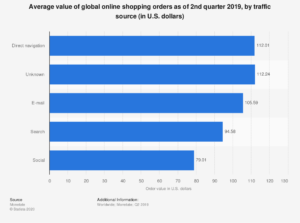
Building a social media presence can drive revenue. 75% of online shoppers say they use social media as a part of their buying process, because people research the brand and what it sells, look for other people’s reviews on social media platforms, and draw conclusions based on what they read online. 55% of online shoppers, said that they considered a company’s ethics and morals when making purchasing decisions and 88% of people are pre-researching online the brand, products, and services, before proceeding with the final purchase.
Additionally, companies can and should promote their products and services on social media; as this report shows, 55% of individuals have bought something online after discovering it on social media.
Acquiring customers and retaining them is a long process that includes not only engaging with them, but also offering them a high-quality shopping experience with an optimized and well-organized website. All your efforts will mean nothing if your customers are having a bad experience with your site. So, to avoid these scenarios, you must prioritize your customer’s needs and direct your efforts towards simplifying their experience with your business. This includes providing a website responds quickly, includes all the necessary information for them, and most importantly, has a safe and optimized checkout flow.
According to a checkout report, the average cart abandonment rate is 68%, and specifically, two out of three consumers are abandoning their shopping cart after browsing the shop and filling the cart with items. In fact, the same report highlights one of the primary factors why this is happening: 21% of shoppers are abandoning a potential order due to a difficult or a long checkout process. In order to improve conversion, always prioritize your shoppers’ experience with your digital store, optimize your checkout process with easy-to-follow steps and a great design, and include everything that your customers need to know before placing an order.
When it comes to payment methods, as Statista’s insights show, 42% of online shoppers prefer use their credit cards when making online purchases, 39% of online shoppers choose PayPal, and only 23% adopted the cash-on-delivery method. Giving your customers a variety of payment options will lower your cart abandonment rate and improve your conversion rate. The faster and more easily an individual can complete your checkout steps, the more chance they will eventually finalize their order.
Besides having an easy and optimized checkout flow, another important aspect is to develop a user-friendly interface for multiple devices, including tablets and mobile devices, in addition to your website page. Mobile shopping is extremely popular these days, as 49,2% of online consumers are using their mobile devices to shop and browse online stores, and by 2021, this percentage is expected to rise to almost 54%.
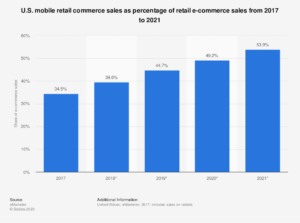
Many online shoppers are expecting free shipping, as this report identified. 75% of them want free shipping and 44% of consumers abandon a shopping cart due to high shipping costs.
More interesting eCommerce statistics to look for
- 6% of online shoppers abandon their cart, just because they only wanted to browse or were not ready to purchase.
- 61% of online shoppers claim that the search and navigation tools in an online store are the most important factors for their online shopping experience, as they allow them to find items more easily.
- 21% of shoppers abandon a shopping cart because they must create an account in order to finalize their order.
- 60% of people purchase a product after originally reading a blog post about it.
- By 2021, early adopter brands that redesign their websites to support visual and voice search will increase digital commerce revenue by 30%.
- 75% of online consumers prefer brands to personalize their offerings and messages.
Summary
In a world where eCommerce dominates, it is important that every business adapts, whether it operates online or plans to do so in the future. Online purchases are increasing each day because consumers prefer the convenience and speed of shopping online for anything they want and need. As eCommerce takes over traditional retail, e-retail sales are steadily growing. According to Statista’s findings, e-retail revenues are expected to reach 6.54 trillion US dollars in 2022.
These statistics have the power to help you shape your business and your eCommerce performance. Knowing insights about digital commerce, shopper’s behavior and how to simplify their shopping experience, can give you a better image of how you can make your business succeed in a digitalized era.
Tip: Interested in more stats and trends in global sales of software, SaaS, digital goods, and online services? See 2Checkout’s latest Digital Commerce Benchmark.

